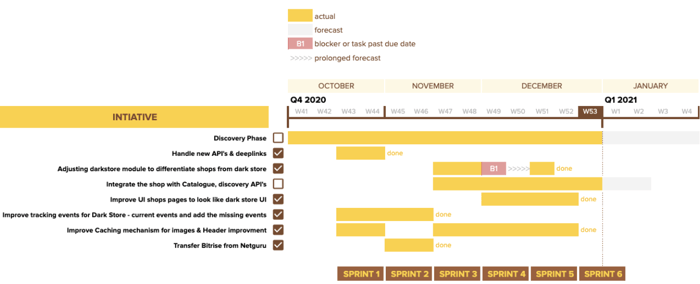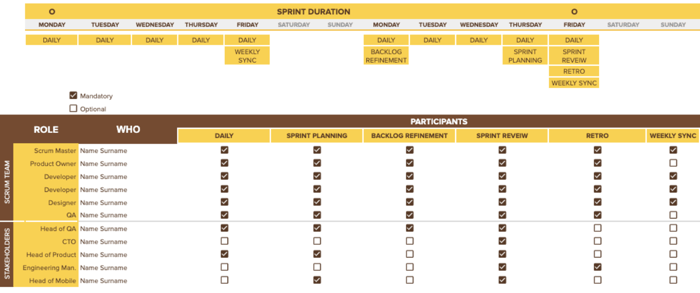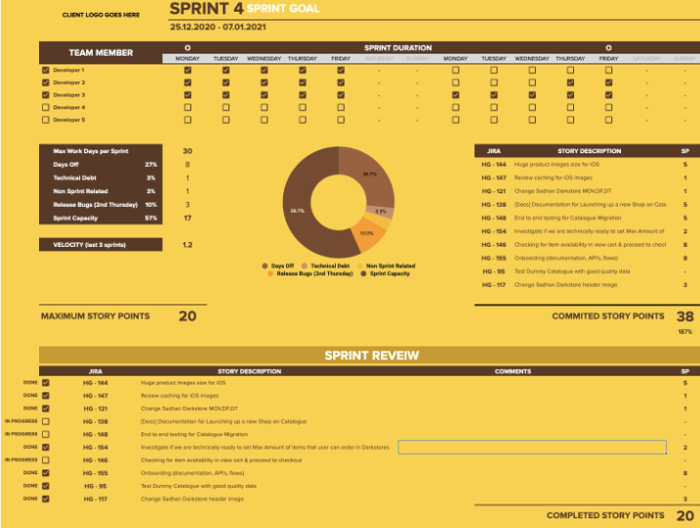How to Excel at Sprint Planning in Agile Project Management?

What is a sprint planning meeting in agile?
In agile project management, the process of creating new products is divided into sprints - short episodes of time during which specific development work must be completed. It’s essential to plan the workload ahead and this is done at an agile sprint planning meeting. In essence, the purpose of the meeting is to determine the features and functionalities that will be included in the sprint and how that work will be achieved.
To this end, every agile sprint planning meeting must yield two outcomes:
- The Sprint Goal: The overarching goal of the upcoming sprint, which is the formal outcome of a given sprint. This is a high-level, one-sentence description.
- The Sprint Backlog: The tasklist required to reach the goal, defined in the backlog. It’s the Product Owner’s responsibility to choose the backlog items for each sprint. The Agile team is free to decide how it’s going to meet these requirements.
While the goal and the backlog details (with their respective acceptance criteria) will be specified by the Product Owner, it’s crucial to understand that this process is a collaborative effort of the entire Scrum Team - teamwork is a prerequisite for success in driving the project towards the product vision.
An agile sprint planning meeting is also an opportunity to clarify ambiguities and collect information from every team member, necessary to plan the upcoming sprint in detail. Indeed, at this time every team member notes and understands their scope of work during the upcoming sprint. The scrum team may also invite other people for technical or domain advice if need be.
The elements of sprint planning
A sprint planning meeting is an opportunity for every team member to have a say on their workload and when it’s going to happen. Plans created during this meeting provide details as to the distribution of tasks, delivery times, and work schedule. Here’s what’s involved in a typical sprint planning meeting:
Backlog management
This first stage of agile sprint planning is about identifying the priorities for the upcoming sprint, focusing on delivering the most important features or functionalities first. Product Owners should begin by reviewing the product backlog items. This review should take into account the following:
-
Items that weren't finished in the previous sprint
-
Action points raised during the retrospective
-
Feedback provided by stakeholders during the previous sprint review
Based on the above, they will identify what needs to be completed in the upcoming sprint and establish the Sprint Goal.
Task planning
Once the features have been identified, the development team will list specific tasks required to develop a particular feature. These tasks are then distributed between the team members. If you know that a given task will take longer than one day, divide it into smaller stories. In this way, it will be much easier to estimate the duration of the entire project and eliminate uncertainties.
Agile estimating
Once you have identified the tasks required to complete the Sprint Goal, agree the time required to complete these tasks with the team. Always take into account the team’s capabilities as well as their past experiences. At this point, concentrate on the small units of work rather than high-level estimations. Do not forget to consider what was agreed with the customer (especially in terms of cost and planning the priorities!).
Agile scheduling
This final part focuses on scheduling work for the immediate and upcoming iterations. Watch out though, because scheduling too far into the future will limit the adaptability of the agile project management process. Make sure to clarify dependencies with the team and schedule accordingly to avoid issues. In addition to development, agile scheduling should also allocate time for design and testing, so make sure the entire team is involved in this component.
How long is a sprint planning meeting?
The length of every sprint planning meeting depends on the duration of the upcoming iteration. If it lasts one week, planning it should take about two hours. For longer sprints, the time required to set a plan increases proportionately, so for a monthly iteration, plan a full-day sprint planning meeting.
The benefits of spring planning in agile project management
Sprint planning in agile project management is essential for productivity and ensuring work gets done, but its role doesn’t end there.
Planning the sprint:
- Maximizes efficiency by helping the team to do the right work - nothing more and nothing less.
- Guides the scrum team’s work and helps them to reach a common understanding of the goal, the backlog tasks and their distribution in the upcoming sprint.
- Is an excellent communication platform for clarifications, asking questions and reviewing the Definition of Done for each task.
- Is the prerequisite for successful teamwork: it’s common for team members to go back and forth to work out the task and scheduling details.
- Helps the entire team understand task dependencies which is necessary to eliminate the risk of getting stuck.
- Is also the opportunity to review the technical side of programming and what’s feasible to implement in the current sprint.
- Is crucial for understanding the team capabilities and estimations, which are key to setting achievable goals and minimizing the risk of team burnout.
Product Owners and team leaders should always make sure there is enough space to discuss these issues, especially if they manage remote teams.
How to improve sprint planning?
Detailed plans increase the team’s chances for successful completion of the sprint. Ensure you have the tools necessary for recording and monitoring the details agreed during sprint planning. At Netguru, we pay particular attention to these details and visualise them as much as possible. Here’s what we mean:
- Forecasts presented as part of high-level project plans to be shared via weekly summaries

- Lists of project participants and events, such as retrospective and weekly sync, planned day-to-day wherever possible

- Facilitators identified for every meeting and event

- Daily team capacity and commitment, maximum story points and their resolution rate

With these tools we stay organized and trustworthy, and know who, what, where, and when at all times.
Plan the sprint of your agile project management
An agile sprint planning meeting is a collaborative effort at establishing a solid plan of action for the upcoming sprint. By preparing high-level and detailed plans you ensure the project focuses on delivering value and on-time results. It helps you stay organized, coherent and trustworthy and keep everything under control.
Planning includes selecting features from the backlog for delivery, identifying tasks, estimating their completion time and scheduling the work in collaboration of the entire scrum team allows to eliminate dependencies, maximize efficiency and foster the team spirit. The better the plan, the more likely your team is to succeed at delivering the product.















.jpg?width=384&height=202&name=Netguru-Biuro-2018-6425%20(1).jpg)







